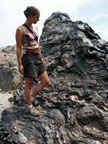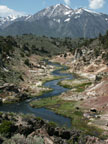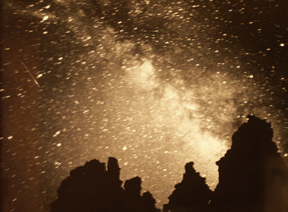 We
plan day and evening trips to Mono Lake, the bizarre obsidian formations of
Pahnum crater, and other locations for planetary geology and astrophotography
amid the tufa towers and the spectacular Eastern Sierra..
We
plan day and evening trips to Mono Lake, the bizarre obsidian formations of
Pahnum crater, and other locations for planetary geology and astrophotography
amid the tufa towers and the spectacular Eastern Sierra..Our Summer '04 Trip is Done! Check the Highlights Page
Astro 30 is an expanded version of Astro 28. While Astro 28 focuses on individual unique topics, Astro 30 is more comprehensive, covering the breadth of field astronomy topics each time it is taught. It is generally taught as a 5 night field trip to a remote dark sky camping spot during the summer. It is suitable for 2 units of CSU science elective credit. It was taught regularly in the early 1990's. Since then, budget cuts have prevented it being offered, as summer classes are beyond the regular salary of the faculty. However, we have approval to offer Astro 30 once again in the summer of '04.
This class is conducted at Oh!
Ridge campground on June
Lake in the eastern Sierra. The skies here are very dark.  We
plan day and evening trips to Mono Lake, the bizarre obsidian formations of
Pahnum crater, and other locations for planetary geology and astrophotography
amid the tufa towers and the spectacular Eastern Sierra..
We
plan day and evening trips to Mono Lake, the bizarre obsidian formations of
Pahnum crater, and other locations for planetary geology and astrophotography
amid the tufa towers and the spectacular Eastern Sierra..
 The final lecture will be conducted at
Hot Creek Geothermal area, (shown at left) where students can float in the
alternating warm and cool waters coming down from the snow and bubbling up from
the hot sands underfoot while listening to me lecture on the origin of the universe,
of life, and the cosmology of large scale structure.
The final lecture will be conducted at
Hot Creek Geothermal area, (shown at left) where students can float in the
alternating warm and cool waters coming down from the snow and bubbling up from
the hot sands underfoot while listening to me lecture on the origin of the universe,
of life, and the cosmology of large scale structure.
Other day explorations will include hot springs in the Bridgeport area, the Owens River, the Sierra Nevada Aquatic Research Laboratory, glacier-carved features at Convict Lake, volcanic ash deposits near Mono Lake, Basin/Range topography at the ghost town of Bodie, and the Long Valley and June Lake volcanic calderas.
Astronomical highlights for the summer '04 class will include Comet
T7 LINEAR in the  dark
evening sky, Comet Q4 NEAT (still quite nice high in the Big Dipper now), remarkable
views of the centeral regions of our galaxy, a sunset and evening session exploring
and photographing the tufa formations at Mono lake, and late evenings laying
in our sleeping bags munching chips while we record data on the shooting stars
of the June Lyrid Meteor Shower.
dark
evening sky, Comet Q4 NEAT (still quite nice high in the Big Dipper now), remarkable
views of the centeral regions of our galaxy, a sunset and evening session exploring
and photographing the tufa formations at Mono lake, and late evenings laying
in our sleeping bags munching chips while we record data on the shooting stars
of the June Lyrid Meteor Shower.
Signup's! Signups began on April 29 5pm at my office 706a. Class limit is 30 students. Unlike the other field courses, I've removed the need to see me for permission prior to enrollment. You may register for enrollment right away. However, there is a $35 camping fee which will cover our campground costs. Most students like my cooking! But the rise in campground costs since the schedule was published means that you'll need to kick in another $10 or so to cover group breakfasts and dinners. I'll bring enough food to get us started and let you know the extra fee needed to get you through the week. (Lunchs and daytime snacks - you're on your own). You must see me to take care of this expense. However.... ENROLL NOW! Use HawkTalk or in-person, as you prefer.
If you don't already have a packet, go to my office (706a) and you'll find a brown envelope with Astro 30 map/directions packets outside my door. Important note - It costs $20 to enter Yosemite National Park (valid for 7 days, so you shouldn't need to pay on return) unless you have a special pass. If you want to avoid this, try getting over the Sierra's by the next road north. That will mean driving this route: Santa Cruz -> Hwy 17 to I-680 to I-580 near Livermore over the hill to the central valley and Manteca -> State 120 -> Oakdale, Sonora, and State 108 into the Sierra's over Sonora Pass down to Bridgeport on Hwy 395, and south to June Lake. It'll add an hour or more to your trip, but if you get 20 mpg that's only an extra $7 in gas, so you still come out ahead :).
The schedule for the summer '04 version of Astro 30 is June 14-18 (Mon-Fri nights). The June date will give us greener landscapes, less competition for camp sites, much less likelihood of summer thunderstorms (which usually begin in late July through September) and spectacular snowy Sierra vistas from camp. We'll also be able to study Comet T7 LINEAR, which should be about 6th magnitude, and Comet Q4 NEAT will be even better, high in the Big Dipper. I scouted the planned camping area this past summer in early June and found the weather and conditions to be beautiful. And finally, we'll have the opportunity to search for evidence for a meteor shower discovered in the late 60's but which has not been followed in recent years. The meteor shower is the June Lyrids, which you can read about here, here, and here. Recent images of Comet T7 LINEAR can be found here. A map of June Lake is here and here.
Here's the Schedule: